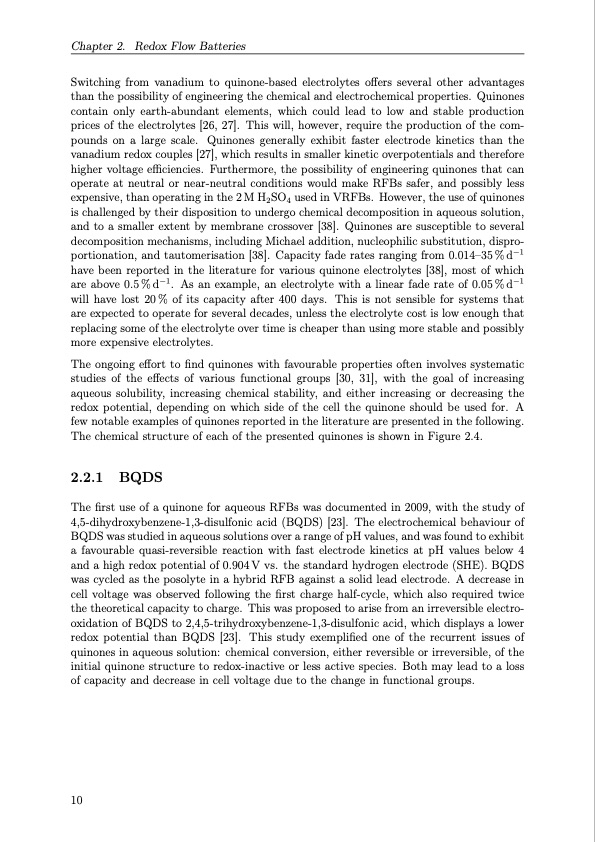
PDF Publication Title:
Text from PDF Page: 031
Chapter 2. Redox Flow Batteries Switching from vanadium to quinone-based electrolytes offers several other advantages than the possibility of engineering the chemical and electrochemical properties. Quinones contain only earth-abundant elements, which could lead to low and stable production prices of the electrolytes [26, 27]. This will, however, require the production of the com- pounds on a large scale. Quinones generally exhibit faster electrode kinetics than the vanadium redox couples [27], which results in smaller kinetic overpotentials and therefore higher voltage efficiencies. Furthermore, the possibility of engineering quinones that can operate at neutral or near-neutral conditions would make RFBs safer, and possibly less expensive, than operating in the 2 M H2SO4 used in VRFBs. However, the use of quinones is challenged by their disposition to undergo chemical decomposition in aqueous solution, and to a smaller extent by membrane crossover [38]. Quinones are susceptible to several decomposition mechanisms, including Michael addition, nucleophilic substitution, dispro- portionation, and tautomerisation [38]. Capacity fade rates ranging from 0.014–35 % d−1 have been reported in the literature for various quinone electrolytes [38], most of which are above 0.5 % d−1. As an example, an electrolyte with a linear fade rate of 0.05 % d−1 will have lost 20 % of its capacity after 400 days. This is not sensible for systems that are expected to operate for several decades, unless the electrolyte cost is low enough that replacing some of the electrolyte over time is cheaper than using more stable and possibly more expensive electrolytes. The ongoing effort to find quinones with favourable properties often involves systematic studies of the effects of various functional groups [30, 31], with the goal of increasing aqueous solubility, increasing chemical stability, and either increasing or decreasing the redox potential, depending on which side of the cell the quinone should be used for. A few notable examples of quinones reported in the literature are presented in the following. The chemical structure of each of the presented quinones is shown in Figure 2.4. 2.2.1 BQDS The first use of a quinone for aqueous RFBs was documented in 2009, with the study of 4,5-dihydroxybenzene-1,3-disulfonic acid (BQDS) [23]. The electrochemical behaviour of BQDS was studied in aqueous solutions over a range of pH values, and was found to exhibit a favourable quasi-reversible reaction with fast electrode kinetics at pH values below 4 and a high redox potential of 0.904 V vs. the standard hydrogen electrode (SHE). BQDS was cycled as the posolyte in a hybrid RFB against a solid lead electrode. A decrease in cell voltage was observed following the first charge half-cycle, which also required twice the theoretical capacity to charge. This was proposed to arise from an irreversible electro- oxidation of BQDS to 2,4,5-trihydroxybenzene-1,3-disulfonic acid, which displays a lower redox potential than BQDS [23]. This study exemplified one of the recurrent issues of quinones in aqueous solution: chemical conversion, either reversible or irreversible, of the initial quinone structure to redox-inactive or less active species. Both may lead to a loss of capacity and decrease in cell voltage due to the change in functional groups. 10PDF Image | Organic Redox Flow Batteries 2023

PDF Search Title:
Organic Redox Flow Batteries 2023Original File Name Searched:
PhD_thesis_final_dorhoff_4_.pdfDIY PDF Search: Google It | Yahoo | Bing
Salgenx Redox Flow Battery Technology: Salt water flow battery technology with low cost and great energy density that can be used for power storage and thermal storage. Let us de-risk your production using our license. Our aqueous flow battery is less cost than Tesla Megapack and available faster. Redox flow battery. No membrane needed like with Vanadium, or Bromine. Salgenx flow battery
| CONTACT TEL: 608-238-6001 Email: greg@salgenx.com | RSS | AMP |